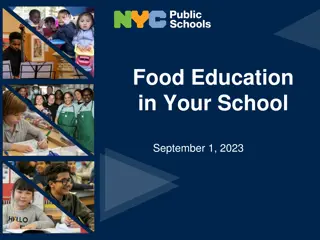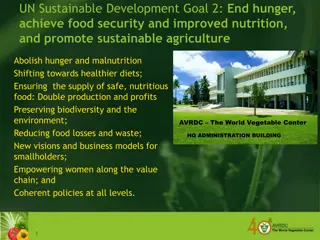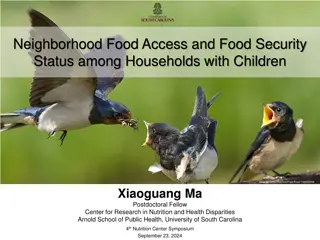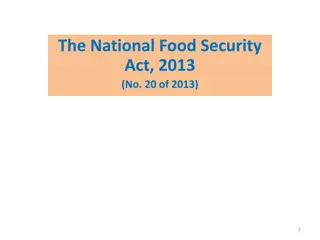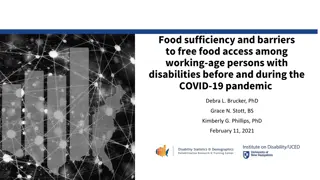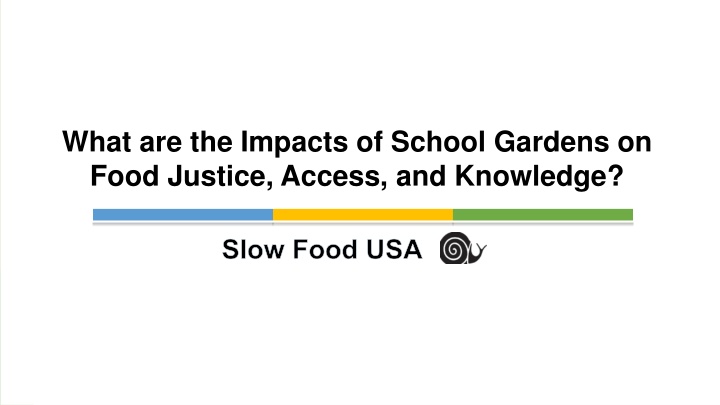
Impacts of School Gardens on Food Justice, Access, and Knowledge
Explore the impacts of school gardens on food justice, access, and knowledge through studies highlighting socioeconomic disparities in school garden provision, the relationship between neighborhood characteristics and garden presence, and recommendations for promoting school garden access in low-income communities. Discover how policies, community support, and funding can play crucial roles in enhancing school garden initiatives.
Download Presentation

Please find below an Image/Link to download the presentation.
The content on the website is provided AS IS for your information and personal use only. It may not be sold, licensed, or shared on other websites without obtaining consent from the author. If you encounter any issues during the download, it is possible that the publisher has removed the file from their server.
You are allowed to download the files provided on this website for personal or commercial use, subject to the condition that they are used lawfully. All files are the property of their respective owners.
The content on the website is provided AS IS for your information and personal use only. It may not be sold, licensed, or shared on other websites without obtaining consent from the author.
E N D
Presentation Transcript
What are the Impacts of School Gardens on Food Justice, Access, and Knowledge? Slow Food USA
Study 1: School Garden Access and Socioeconomic Status Article Details Socioeconomic Disparities in the Provision of School Gardens in Santa Clara County, California by Iris T. Stewart, Elizabeth K. Purner, and Patricia D. Guzman (2013) Program Outcomes Evidence of lack of access for students in lower socioeconomic tracts: No school gardens were located in census tracts where more than 15 percent of the neighborhood households were classified as low income Schools were 4x more likely to have gardens if a lower than average % of students received Free/Reduced Price Meals Plan Large portion of schools without gardens were located in economically disadvantaged neighborhoods with high percentage of non-white residents Those with school gardens identified receiving garden funding mainly from community/parents/volunteers, demonstrating dependency on community s time & money Main Findings Authors identified their main finding as: elementary school gardens are more prevalent in the wealthier and ethnically less diverse communities. with fewer school gardens in the less well-off and more ethnically diverse areas Characteristics common to wealthier neighborhoods with school gardens include: School, community & family support Garden expertise, large outdoor space availability Increased funding Authors suggest that: Policies should be created to recognize, support, and teach about school gardens The authors used surveys and Geographic Information Systems to study the link between school gardens in elementary schools and neighborhoods identified by socioeconomic/ethnic composition in a Californian county Surveys were sent to schools with gardens to assess their needs and characteristics Economic & racial indicators were also used to identify amount of students receiving government food assistance
Study 1 Data: School Garden Access and Socioeconomic Status Socioeconomic Disparities in the Provision of School Gardens in Santa Clara County, California by Iris T. Stewart, Elizabeth K. Purner, and Patricia D. Guzman (2013) Food Access & Garden Presence Schools were 4x more likely to have gardens if a lower than average % of students received Free/Reduced Price Meals Plan Neighborhood Income & Garden Presence No presence of school gardens in neighborhoods where >15% of households were classified as low income Neighborhood Racial Composition & Garden Presence Large portion of schools without gardens were located in economically disadvantaged neighborhoods with high percentage of non-white residents
Study 1 Recommendations: School Garden Access and Socioeconomic Status Socioeconomic Disparities in the Provision of School Gardens in Santa Clara County, California by Iris T. Stewart, Elizabeth K. Purner, and Patricia D. Guzman (2013) Governmental agencies should create policies & practices to recognize school garden benefits Authors Post-Study Recommendations Educational garden tools should be made accessible to students, teachers & parents Grants should be distributed to low- access neighborhoods to support & fund school gardens
Study 2: School Garden Program in a Low-Income, Low- Access Neighborhood Article Details Designing Nature for Learning: School Gardens for Youth and Child Education by Sarah A. Moore, Morgan Apicella, Sallie A. Marston, and Moses Thompson (2012) Program Outcomes Main Findings School garden programs like these help direct students toward healthier food options and make fresh/local food available to food-desert communities The program s implementation facilitated greater access for students to the scientific community, as prior, they were underrepresented in the sciences The program involved garden interns in a school located in a low-income, mixed-race neighborhood (Manzo Elementary School), but in which 96% of students were Hispanic The study received positive feedback from all involved (e.g. teachers, students, parents, interns): Manzo Elementary School was able to reinforce education through the use of the school & community-supported garden Gardening at Manzo makes me feel unique I feel mature -4th grader 93% qualified for free/reduced lunch Students received 30-min. of gardening lessons per week Students interacted with rainwater cisterns, vegetable garden & aquaponic gardening system The garden became a cornerstone for the school s focus on the environment as an important area for learning The formation of garden committees has been helpful in garnering support to maintain the garden program and mobilizing the community The program combines understandings of local ecologies with improved social and emotional skills The aim was to develop gardens in schools where access to time, funding & garden educators was limited, and food access & insecurity was widespread
Study 2 Data: School Garden Program in a Low-Income, Low- Access Neighborhood Designing Nature for Learning: School Gardens for Youth and Child Education by Sarah A. Moore, Morgan Apicella, Sallie A. Marston, and Moses Thompson (2012) General School Garden Program Challenges Manzo s Successful Solutions Program Details Garden situated in low-income, mixed-race neighborhood (Manzo Elementary School) Lack of Formation of garden committee that garners volunteers to sustain/lead program staff/individuals leading program consistently Each class received 30-min. gardening lessons per week Garden utilized to reinforce classroom learning & integrated into school s mission Integrating garden program into school curriculum Students utilized rainwater cisterns, vermicomposting & aquaponics; grew a heirloom vegetable garden Include community in garden maintenance participation Maintaining school garden over time
Study 3: Shaping Food Environments Through Garden & School-Based Programs Article Details Study Outcomes Creating Healthy Food and Eating Environments: Policy and Environmental Approaches by Mary Story, Karen M. Kaphingst, Ramona Robinson-O Brien, and Karen Glanz (2007) Main Findings The authors conclude that there is: a growing importance of the federal child nutrition programs in providing nutrition to children in low-income families The authors identify the following environments as most significant in shaping food behaviors, particularly among those with limited food access: Individual (biological & demographic characteristics) Social (family, friends, peers, community members) Physical (home, work, school) Macro (food distribution & marketing) Community food access issues can be addressed through: supporting farmers markets in these neighborhoods developing community gardens community support of farmers by purchasing their produce The study s aim was to focus on key settings that shape eating behaviors, particularly for low-income individuals with poor food access For children, authors identify the school setting as the most impactful on eating behaviors Local & federal efforts should focus on fruit/vegetable intake among low- income individuals through: farm-to-school gardening programs vegetable pilot programs nutrition curriculum The physical school setting is most impactful for students food behaviors; programs should: link local farmers to school food service cafeterias and programs and there s a need for classroom nutrition increase student s skills for adopting healthy lifestyles Finally, they state that we need to focus on these broader contexts to facilitate access to and education of healthier foods both for adults and children school gardening education to
Study 3 Data: Shaping Food Environments Through Garden & School-Based Programs Creating Healthy Food and Eating Environments: Policy and Environmental Approaches by Mary Story, Karen M. Kaphingst, Ramona Robinson-O Brien, and Karen Glanz (2007) Key Settings Shaping Food Behaviors Individual (biological & demographic characteristics) Social (family, friends, peers, community members) Physical (home, work, school) Macro (food distribution & marketing) Ways to Improve School Food Setting for Low- Income Students Farm-to-school gardening program Addressing Community Food-Access Issues Supporting & purchasing from local farmers markets Developing community gardens that provide healthy food Facilitate access to & education of nutritious food for students and adults Vegetable pilot program Nutrition curriculum
What are the Impacts of School Gardens on Food Justice, Access, and Knowledge? School garden presence is lacking in low-income, ethnically diverse, food-access neighborhoods (where it is most needed) School gardens increase students confidence, reinforce classroom learning & promote healthy eating Gardens help achieve food justice, knowledge, and equal access among low- income students School settings largely shape students food behaviors; garden presence facilitates healthier eating for those with low food access Community involvement in school gardens helps address low food access issues for students & their neighborhoods

